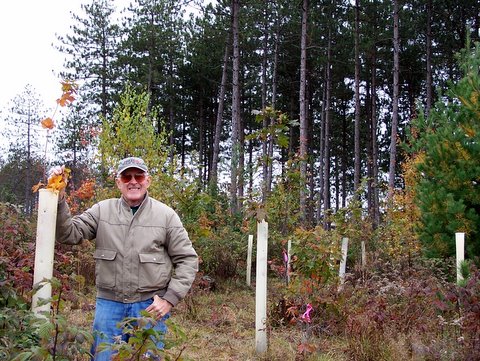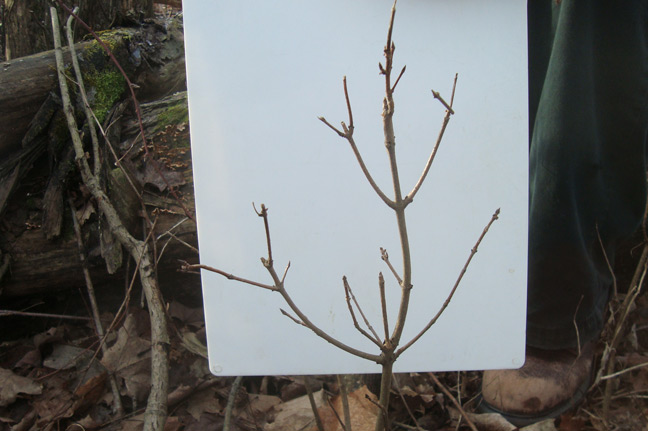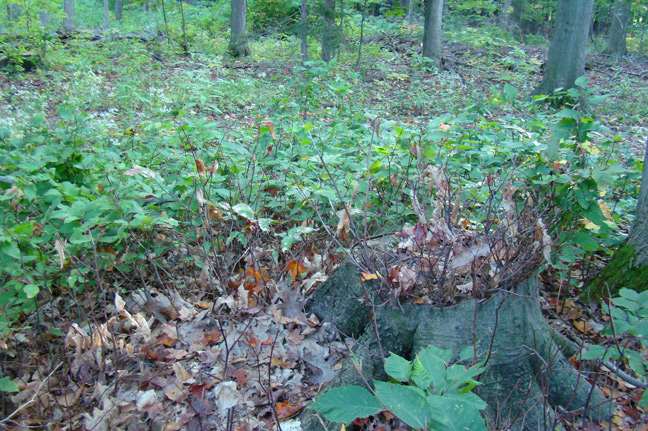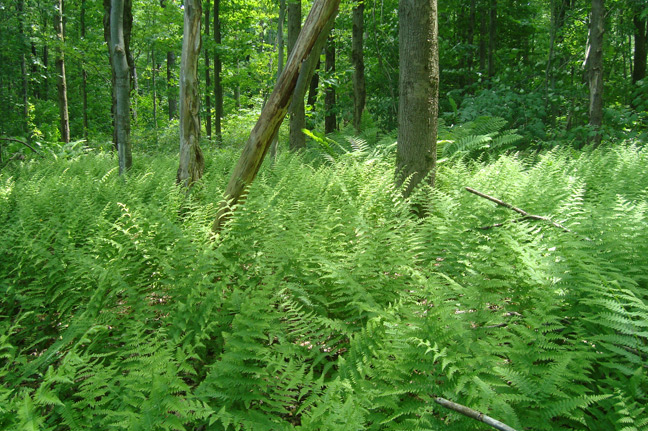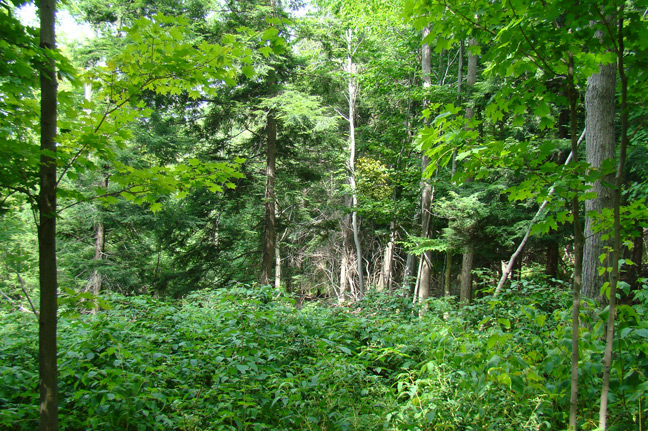Sugarbush Management
Enhancing tree regeneration
Trees are a long-term venture
By PETER SMALLIDGE | SEPTEMBER 2016
Many wooded properties are harvested prior to the sale of the land. Unfortunately, these harvest may not give adequate attention to the multi-year process that is necessary to ensure the woods are successfully regenerated following the removal of numerous canopy dominate trees. Some owners see green vegetation, and assume that all is well. However, previous research has shown that the regrowth is often a “green lie,” and that much of the regrowth is undesirable or insufficient for the needs of the owner. Enhancing tree regeneration might include either favoring existing desired stems or planting seedlings into areas that lack desired stems. In this discussion, the term “desired stem” is used to indicate the plant is a desirable species and has a desirable stem form or quality.
The principles underlying natural regeneration are similar to those of plantation establishment, and described in the Northeastern Tree Planting Bulletin available in the publications section at www.ForestConnect.info[1] Once there is a source of plants, either naturally established or from the seedling nursery, the three key variables related to regeneration success are protection from browsing and rodents, controlling interfering vegetation, and matching the physiological tolerances of the species with site conditions.
Trees are a long-term venture. Thus, any efforts and investments directed at seedlings and saplings should first consider if the physiological tolerance of the tree species matches the conditions of the site. Species have different tolerances for soil moisture, soil fertility, soil depth, aspect, topographic position, and more. These tolerances are often described as silvical or life history traits; details for all common species are available here http://www.na.fs.fed.us/spfo/pubs/silvics_manual/table_of_contents.htm. Although seed of a species may germinate and a seedling may develop, the site conditions may not support that species through all stages of growth and development to the maturity of the plant. Efforts to enhance naturally established seedlings should first consider if the species is matched with the site. Planting should favor only those species that match site conditions. The county Soil and Water Conservation District can assist with determining soil and site conditions, and make suggestions for appropriate species. Soil information is also available online at http://websoilsurvey.nrcs.usda.gov
If post-harvest enhancement will involve naturally established seedlings, focus on species that match the site conditions, species that also match the owner’s objectives, and work to ensure the desired stems are protected from wildlife damage. Ensure also that seedlings have adequate sunlight and soil resources (see below). If post-harvest enhance involves planting seedlings, aggressively cull seedlings before planting to use the most robust and vigorous of seedlings. In one study of artificial planting plus tree tubes (Ward et al. 2005), red oak seedlings that had more than 8 first order lateral roots were 55% taller after 7 years than red oak seedlings with 2 or fewer first order lateral roots. White pine seedlings protected by a tree shelter interestingly had better survival if they had smaller root collar diameters than larger diameters (4 mm vs. 8mm), but early height growth was significantly greater for unprotected large diameter pine seedlings.
The control of interfering vegetation is an effort to reduce the amount of competition experienced by the desired stem from undesired stems. A thorough inspection of the harvested area can allow the owner or a forester to flag or mark desired stems that warrant additional attention. Competition between plants is predominately for sunlight, but soil resources can also be limiting. A US Forest Service study (Schuler et al., 2005) followed red oak seedlings planted into a harvest area following the salvage of mature oak that had been killed by the gypsy moth. In this study, areas with less than 20 sq. ft of basal area per acre in sapling size and larger stems, survival of the planted red oak was almost 80% after 8 years. In areas where average basal area exceeded 30 sq ft per acre, seedling survival after 8 years was approximately 50%.[2] In both cases, undesired saplings were cut to improve the growth and survival of the planted red oak seedlings.
Either mechanical or chemical methods may be used to control interfering vegetation. The first step is to evaluate the plants that need to be controlled, the extent and duration of control, and the potential for damage to desired stems. Mechanical methods might involve the use of a brush saw to cut neighboring saplings or shrubs, or hand pruners to reduce the height of interfering woody plants proximate to the desired stem. Care should be taken with any power equipment, and users should always wear appropriate personal protective equipment. Chemical controls might include a cut-stump control of saplings or shrubs to prevent regrowth, or basal bark treatments to chemically girdle neighboring stems. With both mechanical and chemical treatments, caution is necessary to avoid injury to the desired stem or the operator. More detailed information about forest vegetation management is available through Penn State University http://extension.psu.edu/fvm or at the ForestConnect social media site http://CornellForestConnect.ning.com
Our final, but often most important task is to protect seedlings from damage by deer and small rodents, such as voles. Deer will eat the terminal buds and distort the shape of the seedling
resulting in a multi-branched sapling. Severe browsing by deer will kill seedlings. Voles and other small rodents may girdle the bark from the base of the seedling killing it in one year. Most forestry research on tree planting has emphasized control of deer impacts over rodent impacts, but in some circumstances rodent impact can be significant.
Rodent damage is most problematic on smaller and younger stems, and once trees are more than approximately 1 inch of diameter at ground level, the likelihood of rodent damage declines. Two strategies help limit the impact of rodents on smaller stems. First, control habitat conditions that attract and favor rodents by reducing the abundance of ground level vegetation near the desired stem. Second, bury a mesh or solid plastic tree tube at least two below ground level to prevent rodents from accessing the seedling. Annual maintenance is required to ensure that the tubes remain buried.
Deer impacts on seedlings depend in part on the region of the state. In some northern counties with severe winter conditions, the impact of deer is less than in other parts of the state. Different methods have been used to protect seedlings from deer, and a full account is beyond the scope of this article. At the scale of several properties (hundreds of acres), controlling deer impacts on vegetation can occur through intensive hunting and reductions in the abundance of female deer. Most hunting in NY is sufficiently casual and limited in extent that deer populations are not appreciably reduced. At the scale of a large harvest (scores or dozens of acres), fencing might be considered. Both woven wire and high tensile fencing are feasible, and new technologies with high tensile fencing installation may create new economic and logistical options for owners. A Penn State University fact sheet on deer fencing is available here http://pubs.cas.psu.edu/freepubs/pdfs/uh145.pdf. For harvests at a scale of tens of acres, fencing or translucent plastic and mesh tree tubes can reduce the impacts of deer on naturally established or planted seedlings.
A few points are worth noting about individual protection of tree seedlings. First, for planted seedlings, solid translucent tubes cause the seedlings to prioritize height growth over diameter growth. This causes spindly, etiolated, seedlings that lack stability once the tube is removed. Etiolation is presumably less likely when tubes are used on naturally established seedlings, especially if seedlings are cut to stimulate resprouting. Second, solid tubes can prolong seedling growth into the fall, and inhibit the ability of the seedling to achieve dormancy (i.e., harden-off) before winter. In some circumstances, this lead to significant leader damage and reduction in seedling height following an early winter freeze. Third, as described above, tubes need to be buried and maintained annually. Failure in this regard can result in frost damage and/or rodent damage. Fourth, for hardwood stump sprouts, alternatives to commercial tree tubes that show promise include motel-sized bar soap (Gillespie et al. 1996) and concrete mesh metal cages or deer repellants (Kochenderfer and Ford 2008). Finally, several hardwood species had their best growth in the translucent tubes that provide the highest amount of natural light, those most clear (Sharew and Hariston-Strong 2005). Further, most hardwood species had better diameter growth in the solid translucent tubes with holes that allowed air flow.
In summary, here is a general checklist to help you consider options and strategies for enhancing tree regeneration in a harvested area:
- Assess soil and site conditions. Compare the physiological tolerances of the desired species with the environmental conditions of the site. If suitable species are not present in sufficient numbers, artificial planting may be required.
- Locate and assess the condition of desire stems. If adequate numbers of desired stems per acre are present, determine if stems are constrained by deer browsing or overhead shade.
- Hardwood seedlings that have been heavily browsed by deer might be rejuvenated by coppicing (i.e., cutting at ground level) and then protecting the vigorous sprouts with tubes or shelters, or other protective strategies.
- Seedlings with more than approximately 30% to 40% overhead shade, from the seedling’s perspective, would likely benefit from control of interfering vegetation to reduce competition for sunlight. Similarly, heavy herbaceous cover can limit the survival and growth of hardwood seedlings.
Suggested References
Gillespie, A. R., R. Rathfon, and R.K. Myers. 1996. Rehabilitating a young northern red oak planting with tree shelters. Northern J. Appl. For 13(1):24-29. http://www.ingentaconnect.com/content/saf/njaf/1996/00000013/00000001/art00007
Kochenderfer, J. N. and W. M. Ford. 2008. Utility of wire cages, tree shelters, and repellants to minimize herbivory to oak by white-tailed deer. USDA Forest Service Northern Research Station Res Pap NRS-5. http://www.treesearch.fs.fed.us/pubs/14585
Schuler, T.M., P. Brose, and R.L. White. 2005. Residual overstory density affects survival and growth of sheltered oak seedlings on the Allegheny Plateau. USDA For Serv Research Paper NE-728. http://www.fs.fed.us/ne/newtown_square/publications/research_papers/pdfs/2005/ne_rp728.pdf
Sharew, H. and A. Hairston-Strong. 2005. A comparison of seedling growth and light transmission among tree shelters. Northern J. Appl. For. 22(2):102-110. http://www.ingentaconnect.com/content/saf/njaf/2005/00000022/00000002/art00004
Ward, J.S., M.P.N. Gent, and G.R. Stephens. 2000. Effects of planting stock quality and browse protection type on height growth of northern red oak and eastern white pine. Forest Ecol Manage. 127:2005-216. http://www.sciencedirect.com/science/article/pii/S0378112799001322
[1] This article includes numerous links to web resources. The article will be posted to the Restore NY Woodlands section of www.NYFOA.org and allow viewers to access linked resources directly without retyping.
[2] Basal area per acre is a difficult concept to visualize. Although basal area doesn’t correspond well to the percentage of open sky or canopy closure, basal area above 80 square feet per acre would be mostly no open sky, 50 sq ft per acre would be about 50% open sky, and 20 to 30 sq ft would be roughly 30 to 40% open sky. The point is that seedlings need sunlight to survive and grow.















